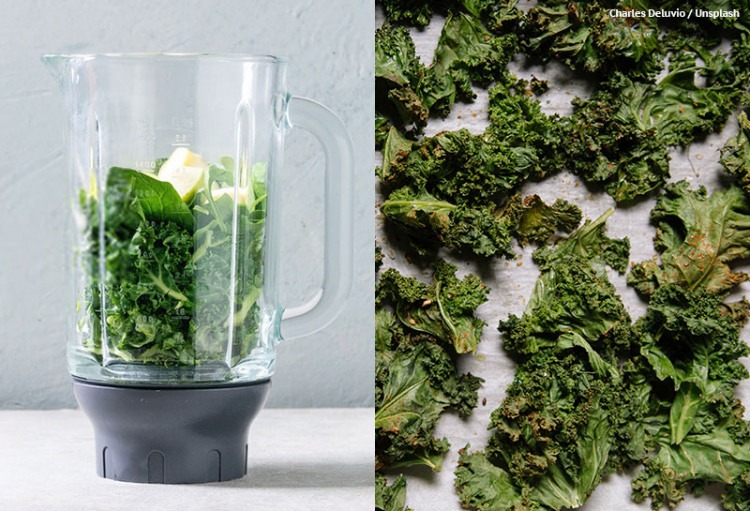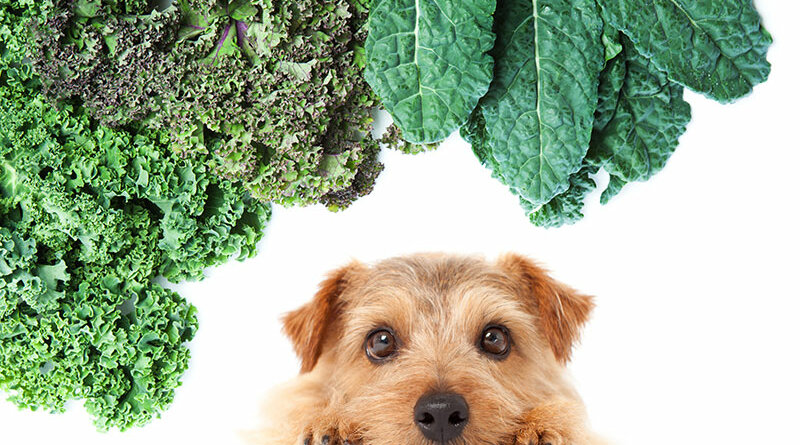Can Dogs Eat Kale (and Other Leafy Vegetables)?
Yes! Leafy vegetables pack a powerhouse of vitamins, minerals, carotenoids and flavonoids linked to better health, especially brain health. They’re also a good source of helpful roughage. Many fall into the cruciferous family, including kale, spinach, chard, mustard greens, beet greens, collards, dandelion greens, broccoli, cauliflower, cabbage, bok choy and brussels sprouts. Here, we’ll kick off with super-food kale.
Benefits of Kale
Kale, one of the most nutrient-dense vegetables, was practically unknown in many U.S. kitchens until the 1990s. A rich source of vitamins A, B6, C and E as well as folate and manganese, it also provides thiamin, riboflavin, pantothenic acid and several minerals, such as iron, potassium and phosphorus. Additionally, kale is a great source of two main antioxidants, lutein and zeaxanthin, (lutein and zeaxanthin) that can potentially protect against cancer.
Adding small amounts of kale to your dog’s diet can support vision and colon health and liver detoxification, and stave off infections. And, if your dog needs to drop a few pounds, lightly cooked kale can be added to her meal as a topper, increasing her satisfaction without adding much in the way of calories.
Types of Kale
There are three main types. The sweetest, Lacinato (also called dinosaur or Tuscan kale) is dark green with long, flat leaves and is the easiest to use. There’s the Curly variety with, yes, very curly, green leaves that’s somewhat bitter, and finally, the mildest of the three, a Russian variety with lobed leaves and magenta stems. (See image above.)
GET THE BARK IN YOUR INBOX!
Sign up for our newsletter and stay in the know.
How to Add Kale to Your Dog’s Diet
Kale is a great ingredient for DIY dog food recipes, both in raw food and lightly cooked recipes.
Boiling diminishes kale’s nutrient profile, so it is best to lightly steam or blanch it. To blanch kale (and other vegetables), quickly submerge it first in boiling water and then in very cold ice water. Blanching is not only a good way to prepare leafy vegetables, it also cleans off any dirt that may be clinging to the leaves and helps retain more of the vegetable’s vitamins and flavor.
Most recipes intended for human consumption advise you to strip the leaves off their woody stems/ribs before cooking. But when using it for dogs, you can include the ribs by chopping or pulverizing and then lightly sautéing or roasting them. You can also reserve the stems and freeze to add to a future meal for your dogs.
Finely slice or chop the leaves. Then, massage the leaves by hand for a couple of minutes, which will make them tender enough to eat without cooking. (That extra massage step makes kale a great salad ingredient for us, but it’s best to lightly cook kale for dogs.)
You can also puree steamed or blanched kale—leaves and ribs included—in a food processor or Vitamix-type blender. Add a splash of the steaming or blanching water to make pureeing easier.
KALE RECIPES FOR THE TWO OF US

KALE FRITTATAS
Check out this recipe from Kathryne Taylor of Cookie & Kate fame for delicious dog-sized baked frittatas. They make a great treat for a nutritious brunch for both of us.
KALE SMOOTHIES, FROZEN TREATS & CHIPS
Many people include kale in their own smoothie blends. You can do the same for your dogs by whipping up a doggie super-food smoothie using kale, blueberries, banana, yogurt, chia seeds and other fruits/vegetables. Freeze in silicone forms or ice cube trays to make refreshing, lickable summer treats, or add a little to a stuffed Kong recipe, then freeze the Kong. Or, use a couple of spoonsful of this smoothie mix as a meal-topper.
Another way you can share this nutritious leafy vegetable with your dog is to make up a special batch of kale chips for both of you. It couldn’t be simpler.
krispie Kale Chips
Preheat oven to 300°. Line a baking sheet with parchment or a silicone baking mat.
INGREDIENTS
- 1 bunch of kale, the Tucson variety is sturdier for chips
- ½ tablespoon olive oil
STEPS
1. Wash and dry the kale thoroughly—it is important to dry it, so the olive oil can stick to it.
Remove the stems and tear the leaves into chip-sized pieces.
2. In a medium bowl, toss and massage the kale chips with the olive oil.
3. Gently lay the chips on a parchment-lined baking sheet; don’t let the chips touch; kale needs space to get crispy. (If you are using seasonings—only for portion of the chips meant for you—such as salt, pepper, smoked paprika, cumin, parmesan cheese, etc., sprinkle on the chips now.)
4. Bake for 20 minutes, turn gently and bake a little longer if you want the chips to be extra crunchy. But watch carefully to prevent burning!
5. Cool the kale chips on the baking sheet for a few minutes; they will continue to crisp up as they cool. (You can always pop them back into the oven at a lower temperature if they do not get crispy enough for your liking.)
It is best to eat the kale chips soon, but leftovers can be stored in sealed container for a short time.




